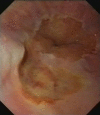Seronegative Herpes simplex Associated Esophagogastric Ulcer after Liver Transplantation
- PMID: 21490847
- PMCID: PMC3075175
- DOI: 10.1159/000119113
Seronegative Herpes simplex Associated Esophagogastric Ulcer after Liver Transplantation
Abstract
Herpes simplex infection is characterized by acute or subacute infection, often followed by a chronic carrier state. Consecutive recurrences may flare up if immunocompromise occurs. Herpes simplex associated esophagitis or duodenal ulcer have been reported in immunocompromised patients due to neoplasm, HIV/AIDS or therapeutically induced immune deficiency. Here we report the case of an HSV-DNA seronegative patient who developed grade III dysphagia 13 days after allogeneic liver transplantation. Endoscopy revealed an esophageal-gastric ulcer, and biopsy histopathology showed a distinct fibroplastic and capillary ulcer pattern highly suspicious for viral infection. Immunohistochemistry staining revealed a distinct nuclear positive anti-HSV reaction. Antiviral therapy with acyclovir and high-dose PPI led to a complete revision of clinical symptoms within 48 h. Repeat control endoscopy after 7 days showed complete healing of the former ulcer site at the gastroesophageal junction. Although the incidence of post-transplantation Herpes simplex induced gastroesophageal disease is low, the viral HSV ulcer may be included into a differential diagnosis if dysphagia occurs after transplantation even if HSV-DNA PCR is negative.
Keywords: Herpes simplex; Immunosuppression; Liver transplantation.
Figures
Similar articles
-
[Esophageal pathology in patients with the AIDS virus. Etiology and diagnosis].Acta Gastroenterol Latinoam. 1991;21(2):67-83. Acta Gastroenterol Latinoam. 1991. PMID: 1820692 Spanish.
-
Acyclovir-resistant herpes simplex virus 1 infection early after allogeneic hematopoietic stem cell transplantation with T-cell depletion.J Infect Chemother. 2017 Jul;23(7):485-487. doi: 10.1016/j.jiac.2017.02.001. Epub 2017 Mar 2. J Infect Chemother. 2017. PMID: 28262533
-
Systemic herpes simplex virus infection following cadaveric renal transplantation: a case report.Transplant Proc. 2006 Jun;38(5):1346-7. doi: 10.1016/j.transproceed.2006.02.100. Transplant Proc. 2006. PMID: 16797299
-
Herpes simplex virus sepsis and acute liver failure.Clin Transplant. 2009 Dec;23 Suppl 21:37-41. doi: 10.1111/j.1399-0012.2009.01108.x. Clin Transplant. 2009. PMID: 19930315 Review.
-
Valaciclovir: a review of its long term utility in the management of genital herpes simplex virus and cytomegalovirus infections.Drugs. 2000 Apr;59(4):839-63. doi: 10.2165/00003495-200059040-00013. Drugs. 2000. PMID: 10804039 Review.
References
-
- Gross G. Herpes simplex virus infections. Hautarzt. 2004;9:818–830. - PubMed
-
- Matsumoto J, Sumiyoshi A. Herpes simplex esophagitis – a study in autopsy series. Am J Clin Pathol. 1985;84:96–99. - PubMed
-
- Pauwels A, et al. Herpes simplex esophagitis in patients with liver disease. Dig Dis Sci. 2002;47:2189–2191. - PubMed
-
- Schneeweis KE. Serologische Untersuchungen zur Typendifferenzierung des Herpesvirus hominis. Z Immunforschung. 1962;124:24–28.
-
- Herrero JI, et al. Herpes zoster after liver transplantation: incidence, risk factors, and complications. Liver Transpl. 2004;10:1140–1143. - PubMed
Publication types
LinkOut - more resources
Full Text Sources



